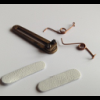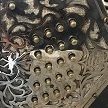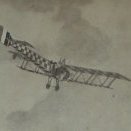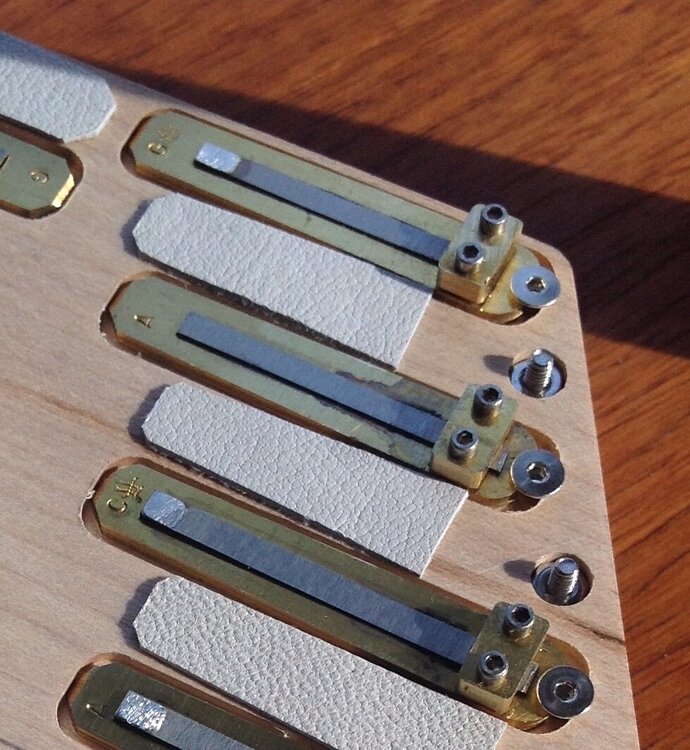-
Posts
835 -
Joined
-
Last visited
Profile Information
-
Gender
Male
-
Interests
Playing ITM and making concertinas
-
Location
Kensington Maryland. USA
Recent Profile Visitors
3,757 profile views
Dana Johnson's Achievements

Heavyweight Boxer (5/6)
-

Kensington Concertinas going dark
Dana Johnson replied to Dana Johnson's topic in General Concertina Discussion
Finally got the site taken down today. all requests for tuning or repairs should be directed to Bob Snope at the Squeezebox Garage in Asheville NC. He is one of the best repairers around and still has a lot of good years left. He inherited a lot of my stuff, so is more likely to have original materials that suit these instruments, though there are other good repairers who can probably manage just fine in most cases. I’m in the process of putting together an ebook and downloadable pdf I’ll put on my Dropbox for those interested. It deals with all the aspects of Kensington Concertinas I can think of from manufacture to repair. ( I may include reed profiles for my instruments, but people wanting to make concertinas should really think about making their own. My style of reed may not be what suits others. ) meanwhile, I can be pm’d through Concertina.net. best wishes to all Dana- 12 replies
-
- 10
-

-

-
Hi All, illness forced me to cut short my concertina making activities more abruptly than I expected. I am shutting down the Kensington Concertinas website, and with it, my dana@kensingtonconcertinas email address. I should still get PMs from concertina.net. however, all repairs or tuning requests should go to Bob Snope at the Squeezebox Garage in Asheville NC. https://www.squeezeboxgarage.com I’m leaving you all in the best of hands. We’ve worked together on and off for the last 30 years, and nobody does tuning and repair better than he does. Hopefully I’ll come through this alright, but I want to give myself a chance to explore interests I never had time for hope all your concertina journeys are as rewarding as mine has been. Dana Johnson
-
Cher1 Anglo Player started following Dana Johnson
-
I am happy to share what knowledge I’ve gained with anyone interested and am working on getting it down to a readable form that hopefully will be able to jump start interested folks. I am planning on finding a good home or homes for what stock of parts I will have left over, though there isn’t anything hard to make. Dana
-
Hi everyone, I’ve been at this a long time and finally decided to take down the old shingle. I am stopping making new concertinas after I use up my existing stock of materials, and as of last week, have all the orders I will take, hopefully to finish up in 2025. 75 seems like enough. I will still do repairs on Kensingtons for as long as practical, but I plan to move out most of my shop tools before I am no longer capable. I will take down my website soon and with it the @kensingtonconcertinas email. I sincerely hope there are younger folks out there that will pick up making concertina reeded instruments , especially making your own reeds. It isn’t a lucrative endeavor, but if you do good work, there is some payback in the pleasure your instruments will bring. One advantage today is that the demand for new high quality instruments is much greater than when any of my generation started. There are a good few people making hybrids right now that are a step up from a Rochelle, making it easy for people to get into, but there is no reason why instruments as good as the best Wheatstones or Jeffries shouldn’t be available new. There isn’t any secret to making them, only good materials, good design, good reeds and a desire to do the best you can. Best Wishes to all. Dana Johnson Kensington Concertinas
-

What are metal ends made of?
Dana Johnson replied to Andy Holder's topic in Instrument Construction & Repair
I was lucky to be able to buy my NS C735 with only a 50 lb. minimum, though I am near the end of my second 50# coil. I was able to get it rolled to the exact width and temper ( 1/2 hard ) I wanted. I made my wife’s 25 years ago and it is still bright as the day it was made. NS comes in a number of different alloys which vary in properties as well as color. The C735 is used primarily for things that require a silver appearance like ornamental belt buckles, jewelry etc. people with corrosive sweat will dull and erode it if not wiped down regularly. Some environments also dull it after a few years. Nickel is no remedy for corrosive environments. My sweat ate through the nickel plate on my old bastari exposing the brass underneath which then got eroded as well. Chrome is very resistant, but unpleasantly cold in color to my tastes. A jewelry polishing cloth used occasionally will keep up the shine, but more aggressive polishing is required for badly dulled ends. Plating also has a nasty habit of flaking away especially where it has worn through. I had one set of ends nickel plated many years ago, with the NS alloy I was using, you couldn’t tell the difference do I didn’t do any more. Stainless is easy to get laser cut, while copper alloys like NS may require something other than s CO2 laser since it doesn’t couple well with infrared wavelengths and requires much higher power. Stainless can be a bit cold too though. -
Nothing special about round ends. It is important to cut the valves with the direction of least stretch as the long direction of the valve though.
-

Reed slot stepped profile
Dana Johnson replied to 4to5to6's topic in Instrument Construction & Repair
Marcus had reeds made similarly but with the back relief cut with a circular cutter like a woodruff key cutter. He was trying to mimic the tapered windows on concertina reeds in his hybrid instruments. Wheatstone mostly created the taper as part of the punching process in relatively soft brass, finishing the window sizing with small broaches. I experimented with different methods to reduce the volume of a low drone reed, first by making a verynarrow reed, then changing the relief angle, and finally using an end mill to reduce the thickness at the window similarly to the reed in the image to about .020 inches. This was the only way that produced a very noticeable reduction in volume. What seems to happen is that reducing the thickness limits the distance the air flow can add power to the reed. I once made a few reed sets with bell mouth shaped windows similar to an old Jeffries I had. This had the effect of changing the pressure / volume curve so that small increases in pressure had greater effect on the volume. I used curved scrapers to creat the belling which was actually quicker than filing. These reeds worked very well, but I stopped doing it because I wanted more control on the dynamics. One thing to keep in mind is how different parts of the reeds scale. A long reed in a window of a given thickness swings through a shallow angle before it exits the back of the window. A short reed in the same thickness has to swing farther to exit the window. One way to attempt to equalize this across the reed lengths is to vary the vent angle, from nearly zero at the low end to much greater for the high end. Very low reeds may need thicker shoes to get good volume. I have a set of bass accordion reeds that have windows in cast plates that are about .375 inches deep at the tip end of the reed. ( the plates are tapered so they are thinner at the root to save weight I expect ). The other way you can do this is to use the same angle throughout but change the reed stiffness so shorter reeds bend more easily at the same playing pressure. Practically speaking, some attention to this issue is necessary to get sufficient volume of the mid to higher reeds without having to use more bellows force. Getting this right produces very noticeable effects. I found that regarding vent angles, each reed length has an optimum vent angle above which the reed loses its maximum volume and below which volume at a given pressure drops off. This also holds for making reeds thinner which will respond at lower pressures, but max out at lower pressures as well. With my reeds, I change the vent angle in steps about every octave and that has made for very even response across the range. ‘Reeds made by someone else would need their own set of angles. There is no one right angle, especially since choices in reed profiling directly affects the issue. The milled out reeds in question are in my opinion, a quick and dirty attempt to deal with this issue. That seems in keeping with the later cost cutting attempts at the Wheatstone co. -
Seán Ó Fearghail started following Dana Johnson
-

questions about making tongues
Dana Johnson replied to lucayala's topic in Instrument Construction & Repair
Tom, my maximum is .0015 inches/side, but minimum is .001”. I can do tighter, but the high harmonics go up too much and the centering accuracy needed for pitch stability becomes substantially harder since an error of .0001” is a much larger percentage of a very small gap. Very small gaps increase the chance of a reed buzzing or impinging on the frame. This will affect single reed shoes with narrow window sides more than a plate with wider metal at the perimeter, and affects longer reeds more compared to short ones. Smaller clearances can increase responsiveness, but I find there is a limit to their utility. Tight clearances also require progressively more careful and difficult fitting with decreasing benefit. On the other side, wide gaps rapidly decreases reed responsiveness and makes for poor reeds. The ideal is to find the clearance that produces your best playability and tone results and to try to reproduce that to very small tolerance, say +/- .0001” or .0025mm ( then center it as perfectly as you can ) I recently made 16 new tongues to match badly rusted Wheatstone reeds in the 5th and 6th octave range, and did those to .0007”/side but these were small to tiny reeds, so the small gap was more proportional to their length. Dana -

Cleaning up Nickel Siler ends
Dana Johnson replied to Marcus's topic in Instrument Construction & Repair
Already spoke with Marcus, for reference. The ends are C735 NS which is 18% nickel. I have it rolled to my specs 1/4 hard for better bending resistance. I tried bright overplating with nickel, but unless it is very thick, it wears off and is not more resistant to erosion from the corrosive sweat of certain people. This alloy is what is used for things like belt buckles of the sort you find in New Mexico next to turquoise. The alloy I have seen in Jeffries and Wheatstone is a slightly yellowish alloy in comparison. You can see the difference where any plating has worn off. There is no visible difference in color between bright nickel and the C735 I use “sunshine cloth “ to remove tarnish, though the sort of polishing cloth you can get at a jewelers for gold and silver works as well. Marcus’s instrument has been with other owners for many years, and while it had some spots where hand or finger contact had dulled the polish, overall, it was still untarnished. Something changed in Bermuda which isn’t surprising considering the sea environment. Chris Ghent mentioned to me something about NS turning a bit yellow in a freshly glued case. That isn’t the case here, but it does show the alloy has a vulnerability to certain atmospheres. if you are trying to remove scratches or pitting, abrasive paper finishing with 1500 grit , then polishing with an appropriate compound works, but on a plated end you’ll cut through the plating that way and it is better left alone. The best way to keep an instrument looking good is to wipe it down with a lint free cloth dhen you are done playing. My wife’s concertina is 22 years old and looks pristine. Btw, I have about a half of a roll of the C735 alloy left from my second 50 pound roll which I probably won’t use up. It is 6 inches wide X .025” thick which is what I needed for my pressed ends. I haven’t weighed it, but probably about 25 lbs left. It is s large diameter roll and unrolls fairly flat. Dana -
Flap valves for concertinas need to operate at very low pressures compared to their use in organs. While the playing pressure may go up to perhaps 4 inches of water column, the valves need to open at much lower pressure in order to play softly and not obstruct the air flow.. This means they should be as flexible as possible, yet still have enough spring to return to flat once the pressure ceases. Dense leather needs to be quite thin to lift at low pressure, but it’s weight at those thicknesses make it vulnerable to sagging away from the reed pan. If they are thick enough to resist this, they don’t lift easily enough and dull the sound. Leather that is less dense can be thicker and gain spring by having the surfaces farther away from the center of bending. Heavy hides like cow are very dense at the hair side, and if split thin enough lose most of the less dense flesh side. The optimum comes when the leather comes from smaller animals whose skins are much thinner to start with and include the least dense portion with the hair side being a smaller proportion of the thickness. Low density valves require less spring force to close or keep from sagging even when they are thicker. A lot of older instrument’s valves were alum tanned or tawed hair sheep , a naturally white leather with a tight outer grain from the alum which gives good spring without adding weight. Unfortunately, it also creates a slightly corrosive environment which can turn brass reed shoes dark where they have a valve next to them. Alum tanned leather still has dome alum in it and will rot if the alum is completely washed out. Finding leather that mimics alum tanned is a good goal, and the Columbia CPL at least works pretty well, while other leathers they have aren’t as good. The aolian Morton CML maroon version of the CPL is treated with heat to help seal the grain side, and it can work well, but they don’t have it any thicker than their CPL which is my only complaint for either. Welling and drying flat still may need to be done if it comes too soft. Dana
-
Just for reference, the extra heavy CPL from Columbia is heavy only in the context of organ pneumatics. It is too thin for valves for notes below midrange. Their “valve” leather is substantially heavier. But the valves in question are organ valves. I wish they would carry their CPL in “ultra heavy “ around .028-.032” their skins are not that even in thickness and the top number they list for each weight may only be reached on dome pieces. I always thouroughly wet it and dry it on glass because it Is tumbled softer than good flap valves should be. Dana
-

Quality Difference in Concertina Play
Dana Johnson replied to David Lay's topic in General Concertina Discussion
Concertinas with limited range can get by with one pad hole size, but it isn’t ideal. Large low reeds need larger hole sizes or they will starve their reeds at higher volume. Small reeds behave better and sound clearer with smaller holes. Concertinas with a large range of notes really need to have a gradation from low to high, though this can be in 3 or more steps. I set my pad hole sizes by using the smallest hole that didn’t starve the reeds ( causes a fairly sharp tonal change where higher overtones drop out ) a baritone’s low notes use a lot of air and need large enough pad holes to allow them. To have the reed be the limiting factor on air, not the hole. You might think the hole has more area than the reed gap, or even the open reed, but the effect is there never the less. We may need to think of the pad’s air space being the ring of gap around the pad as it lifts. The effect is similar to a pad not lifting high enough. My set of Wheatstone baritone reed pans have larger reeds than the same pitches in a treble or tenor treble. The low reeds overpower reeds not designed to match them. By all means, start by copying. A great deal of trial and error has already been done a hundred years ago by very clever people. Dana -

Replacing springs.. what is the secret?
Dana Johnson replied to seanc's topic in Instrument Construction & Repair
Whatever you use, make your coil size a little larger in diameter to the old originals. That alone will dramatically increase the spring lifespan. At a certain point, fatigue drops to near zero. My springs are still fine after 4 million cycles, up from 10,000 of the same wire at the coil size of trad concertina springs. While music wire steel can make fine springs, it does rust compared to that ruthless SS. I like to keep carbon steel out of concertinas, since the wood it touches absorbs moisture from the air and is never truly “dry”. Often the steel screws that attach hand rests on old instruments and the like are badly rusted. Brass screws poor shear strength still leave steel as better if not great because you generally can still unscrew them. -
4to5to6 started following Dana Johnson
-

Push Reeds Sink with High Pressures
Dana Johnson replied to Dissonance's topic in Instrument Construction & Repair
A couple other possibilities are hardened valves that don’t lift enough, also pads that don’t lift high enough, which will pull the pitch down when they won’t allow enough air to pass, especially if the concertina has smaller pad holes. Also as mentioned in another thread, the pins that keep the valves from lifting to far can be set too close to the reed, which causes the same issue as pads that don’t lift enough, and affects the press reed valves which are the only ones with pins, (except for large valves on low pitched instruments which can have a wire or other device to keep the bellows side valves from flopping away from the reed pan.










